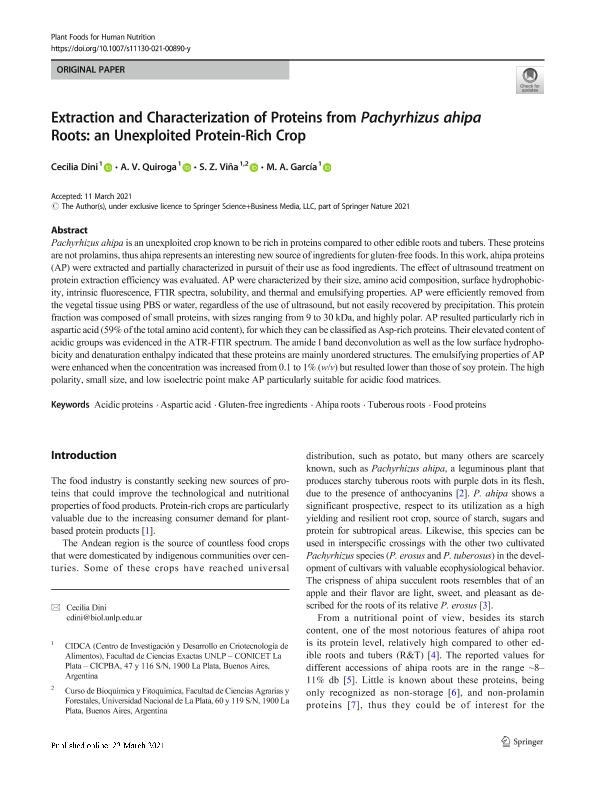Mostrar el registro sencillo del ítem
dc.contributor.author
Dini, Cecilia

dc.contributor.author
Quiroga, Alejandra Viviana

dc.contributor.author
Viña, Sonia Zulma

dc.contributor.author
Garcia, Maria Alejandra

dc.date.available
2021-07-08T12:24:44Z
dc.date.issued
2021-06
dc.identifier.citation
Dini, Cecilia; Quiroga, Alejandra Viviana; Viña, Sonia Zulma; Garcia, Maria Alejandra; Extraction and Characterization of Proteins from Pachyrhizus ahipa Roots: an Unexploited Protein-Rich Crop; Springer; Plant Foods for Human Nutrition; 76; 2; 6-2021; 179-188
dc.identifier.issn
0921-9668
dc.identifier.uri
http://hdl.handle.net/11336/135700
dc.description.abstract
Pachyrhizus ahipa is an unexploited crop known to be rich in proteins compared to other edible roots and tubers. These proteins are not prolamins, thus ahipa represents an interesting new source of ingredients for gluten-free foods. In this work, ahipa proteins (AP) were extracted and partially characterized in pursuit of their use as food ingredients. The effect of ultrasound treatment on protein extraction efficiency was evaluated. AP were characterized by their size, amino acid composition, surface hydrophobicity, intrinsic fluorescence, FTIR spectra, solubility, and thermal and emulsifying properties. AP were efficiently removed from the vegetal tissue using PBS or water, regardless of the use of ultrasound, but not easily recovered by precipitation. This protein fraction was composed of small proteins, with sizes ranging from 9 to 30 kDa, and highly polar. AP resulted particularly rich in aspartic acid (59% of the total amino acid content), for which they can be classified as Asp-rich proteins. Their elevated content of acidic groups was evidenced in the ATR-FTIR spectrum. The amide I band deconvolution as well as the low surface hydrophobicity and denaturation enthalpy indicated that these proteins are mainly unordered structures. The emulsifying properties of AP were enhanced when the concentration was increased from 0.1 to 1% (w/v) but resulted lower than those of soy protein. The high polarity, small size, and low isoelectric point make AP particularly suitable for acidic food matrices.
dc.format
application/pdf
dc.language.iso
eng
dc.publisher
Springer

dc.rights
info:eu-repo/semantics/openAccess
dc.rights.uri
https://creativecommons.org/licenses/by-nc-sa/2.5/ar/
dc.subject
ACIDIC PROTEINS
dc.subject
AHIPA ROOTS
dc.subject
ASPARTIC ACID
dc.subject
FOOD PROTEINS
dc.subject
GLUTEN-FREE INGREDIENTS
dc.subject
TUBEROUS ROOTS
dc.subject.classification
Alimentos y Bebidas

dc.subject.classification
Otras Ingenierías y Tecnologías

dc.subject.classification
INGENIERÍAS Y TECNOLOGÍAS

dc.title
Extraction and Characterization of Proteins from Pachyrhizus ahipa Roots: an Unexploited Protein-Rich Crop
dc.type
info:eu-repo/semantics/article
dc.type
info:ar-repo/semantics/artículo
dc.type
info:eu-repo/semantics/publishedVersion
dc.date.updated
2021-07-01T14:37:28Z
dc.identifier.eissn
1573-9104
dc.journal.volume
76
dc.journal.number
2
dc.journal.pagination
179-188
dc.journal.pais
Alemania

dc.description.fil
Fil: Dini, Cecilia. Provincia de Buenos Aires. Gobernación. Comisión de Investigaciones Científicas. Centro de Investigación y Desarrollo en Criotecnología de Alimentos. Consejo Nacional de Investigaciones Científicas y Técnicas. Centro Científico Tecnológico Conicet - La Plata. Centro de Investigación y Desarrollo en Criotecnología de Alimentos. Universidad Nacional de La Plata. Facultad de Ciencias Exactas. Centro de Investigación y Desarrollo en Criotecnología de Alimentos; Argentina
dc.description.fil
Fil: Quiroga, Alejandra Viviana. Provincia de Buenos Aires. Gobernación. Comisión de Investigaciones Científicas. Centro de Investigación y Desarrollo en Criotecnología de Alimentos. Consejo Nacional de Investigaciones Científicas y Técnicas. Centro Científico Tecnológico Conicet - La Plata. Centro de Investigación y Desarrollo en Criotecnología de Alimentos. Universidad Nacional de La Plata. Facultad de Ciencias Exactas. Centro de Investigación y Desarrollo en Criotecnología de Alimentos; Argentina
dc.description.fil
Fil: Viña, Sonia Zulma. Provincia de Buenos Aires. Gobernación. Comisión de Investigaciones Científicas. Centro de Investigación y Desarrollo en Criotecnología de Alimentos. Consejo Nacional de Investigaciones Científicas y Técnicas. Centro Científico Tecnológico Conicet - La Plata. Centro de Investigación y Desarrollo en Criotecnología de Alimentos. Universidad Nacional de La Plata. Facultad de Ciencias Exactas. Centro de Investigación y Desarrollo en Criotecnología de Alimentos; Argentina. Universidad Nacional de La Plata. Facultad de Ciencias Agrarias y Forestales; Argentina
dc.description.fil
Fil: Garcia, Maria Alejandra. Provincia de Buenos Aires. Gobernación. Comisión de Investigaciones Científicas. Centro de Investigación y Desarrollo en Criotecnología de Alimentos. Consejo Nacional de Investigaciones Científicas y Técnicas. Centro Científico Tecnológico Conicet - La Plata. Centro de Investigación y Desarrollo en Criotecnología de Alimentos. Universidad Nacional de La Plata. Facultad de Ciencias Exactas. Centro de Investigación y Desarrollo en Criotecnología de Alimentos; Argentina
dc.journal.title
Plant Foods for Human Nutrition

dc.relation.alternativeid
info:eu-repo/semantics/altIdentifier/url/https://bit.ly/3hkR9YH
dc.relation.alternativeid
info:eu-repo/semantics/altIdentifier/doi/http://dx.doi.org/10.1007/s11130-021-00890-y
Archivos asociados
